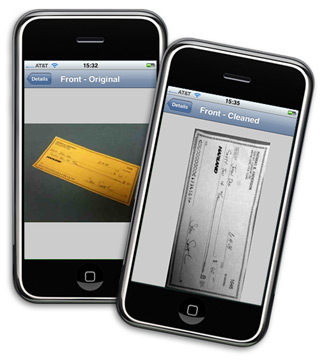Mobile image capture: talk alone or more?
 From the translator . The previous article caused a small but discussion. “The dismal article is about nothing,” said Aram Pakhchanyan (vice president, director of data entry products at ABBYY) in his comments and noted that all publications about mobile capture are in essence a lot of noise about obvious things. We respect the opinion of the opponent, but we can hardly agree with him.
From the translator . The previous article caused a small but discussion. “The dismal article is about nothing,” said Aram Pakhchanyan (vice president, director of data entry products at ABBYY) in his comments and noted that all publications about mobile capture are in essence a lot of noise about obvious things. We respect the opinion of the opponent, but we can hardly agree with him. The use of mobile technologies to capture and digitize information opens up tremendous prospects. Until recently, the ability to scan a business card using a smartphone and enter data into a corporate CRM was perceived by many as exotic. Today it is no longer perceived as something unusual. Work is underway to create applications that recognize snapshots of accounts, extract data from them and transmit to the program for managing electronic payments. How will mobile technologies develop further? What will be the scope of their application? How will they coexist with traditional capture technologies?
In search of an answer to these questions, our company's specialists translated the post from the blog of Joe Buddelli , vice president of sales for ABBYY. Readers are invited to reflect on the questions formulated by the author at the end of the article, and express their opinions in the comments.
')
 Last week, Chris Riley published an article on a topic that is very dear and close to my heart. This is a mobile image capture. I respect and largely share the opinion of Chris, but I want to analyze his article in more detail. Yes, on many points I agree with him - but I still want to argue with some of his theses.
Last week, Chris Riley published an article on a topic that is very dear and close to my heart. This is a mobile image capture. I respect and largely share the opinion of Chris, but I want to analyze his article in more detail. Yes, on many points I agree with him - but I still want to argue with some of his theses.The potential of mobile capture technology I rate very, very high. I also considered mobile capture issues in my publications on the AIIM website. In this post, I will express my thoughts on some of the theses of Chris.
At the very beginning of his post (in the “What is being said” section), Chris says that the human factor is a stumbling block in mobile capture. I do not deny the role of the human factor. Improper lighting or hand-shake during shooting can significantly affect the result. However, it seems to me that this negative influence can be overcome. The hardware characteristics of mobile devices are constantly improving: they are equipped with high-resolution cameras, autofocus, with built-in flashes ... improve the preliminary development of the image. In this direction, you can do very, very much.
I know what you are thinking now: that, despite all the measures taken, the quality of mobile capture will not be the same as can be achieved with stationary scanners. You may be right, but I have another question: is it really necessary, is it the highest quality? Mobile and traditional capture are used (for both personal and work needs) in different situations and for different purposes. Mobile capture is needed to process small amounts of information and speed up its transfer. It was not originally intended for full document recognition - capture with traditional stationary devices is much better suited for this. Two technologies must complement each other.
Then Chris makes an interesting statement: “The user will simply get the result without thinking or even knowing about the technologies used in this case” (meaning primarily OCR technology). This statement is very curious. If you now ask the majority of people using OCR, they are unlikely to know exactly what technology is used to translate paper documents into digital form. This is evidence of a significant improvement in OCR technology: people now take them for granted, people see that it is “working.” Some OCR technology developers have invested more in research, and technology continues to improve.
As I already wrote, the growth of the smartphone market exceeds all expectations and forecasts. And this is also evidence that the future of capture technologies will be very closely related to mobile technologies. And we inevitably have to develop innovative solutions for smartphone users. Regardless of whether users understand the essence of the technologies used or not, we have the opportunity to change the traditional ways of processing information.
Source: https://habr.com/ru/post/174141/
All Articles